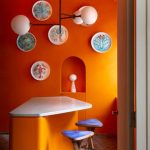The past couple of years aren’t entirely behind us yet, but humanity as a whole seems to be recovering. However, the primary bathroom has remained a refuge for everyone when everyone was always home. We have developed a need for personal space that is unyielding, and we will not give it up easily.
The modern bathroom is a relatively recent concept. Ancient Romans and medieval Europeans, for instance, used public baths as a social and cleansing tool. It wasn’t until the early 20th century that having a discreet bathroom in one’s house was regarded as de rigueur. Today, people redoing their baths are pushing hard to keep that separation.
Founder and CEO of New York design-build firm Bolster, Anna Karp, says people are spending more money on the overall layout of a space than on tiles and fixtures. It is also becoming increasingly popular to have sofas and built-in shower seating. This is partly due to comfort, but also because if a person is aging in place for a very long time, it is quite common. Having a ledge for shaving one’s legs is also useful. Some of her clients are looking for sound insulation, which includes using heavier doors.
In a California home by Studio Shamshiri, sandy hues and a wooden tub blend together.
Johnson, Stephen Kent
A primary bathroom is now more about wellness, according to Los Angeles interior designer Pamela Shamshiri: “What unique spa ritual does the client wish to achieve out of it?” Because you can’t always do everything. (With space constraints, you may have to choose between a steam shower and a large soaking tub.) As people meditate and work in these rooms, furniture such as armchairs and armoires has become increasingly popular. A Rudolph Schindler house Shamshiri once lived in had a bathroom with heated floors on which she used to lie and work for long periods.
In the modern bathroom, there are probably a lot more things going on behind the walls than you could ever imagine.”
The key to a good bathroom is making it more connected to the rest of the house, says New York interior designer Joy Moyler. A recent attempt to combat asylum austerity resulted in her placing table lamps on a long vanity, which she deems to have been a great success. She dislikes cold and clinical spaces, which she describes as “like something out of One Flew Over the Cuckoo’s Nest.” The solution is multiple layers of lighting that can be adjusted for different moods and tasks. “It doesn’t work well for women who want to put on their mascara without stabbing themselves in the eye.” The architect Chris Fogarty of Fogarty Finger, who designed Astoria West, in Queens, New York, is firmly on Team Tub. “If you’re English like me, the bathtub is critical,” he says. For walls and floors, he prefers porcelain tile—especially the new thin, large-format versions—because of their marblelike appearance and longevity. The more simple and sparse the bathroom, the more complicated the construction process is likely to be. It is important to hide steel bars behind floating vanities, for example, otherwise they will sag. He says the modern bathroom has more going on behind the walls than you could ever imagine.
Pink-and-white checkered tiles enclose an enclosed toilet designed by Buchanan Studio.
The Waite family
Separate bathrooms offer couples additional benefits besides being refuges. She has recently received requests from women seeking a medicine cabinet with a lockable drawer that they can use to store their jewelry. She adds, “This is where they can store the good jewelry.” “And if they need to leave in the middle of the night, they can take it with them instead of waiting outside the bank to get into the safe deposit box.”

